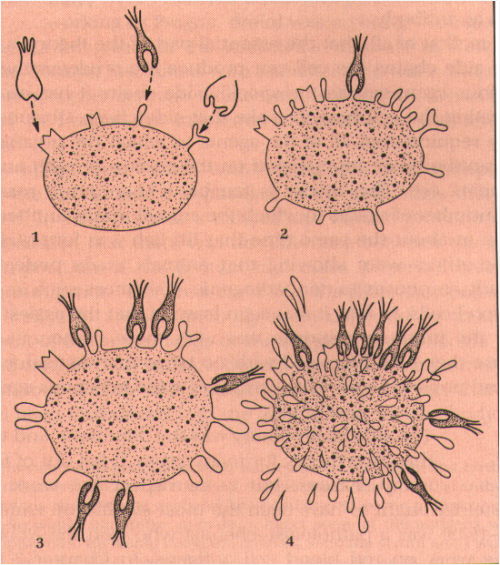Immunology - Blog Posts

Only true fans here.
Art: Cells at Work! by Akane Shimizu
ELISA
Enzyme-linked immunosorbent assay is a plate-based assay technique used to detect substances such as proteins, peptides and hormones.
An antigen is immobilized on a solid surface
It is complexed with an antibody that is linked to an enzyme.
The conjugated enzyme activity is assessed via incubation with a substrate.
Which produces a product that can be measured.

Direct ELISA
Antigen is coated directly to wells of microtitre plate
an enzyme-labelled primary antibody that detects the antigen is added.
Advantages
Fast and minimal steps needed.
Minimum precursor requirement makes it less error prone.
Disadvantages
The immobilization of the antigen is not specific - background interference.
Less flexibility of primary antibody.
No signal amplification –> less sensitivity.
Indirect ELISA
An enzyme labelled secondary antibody interacts with a primary antibody to increase sensitivity.
Advantages
Offers high sensitivity and flexibility as a secondary antibody can label different primary antibodies
It is cheap (fewer labelled antibodies needed)
Disadvantages
Increased background noise from the secondary antibody.
Extra labour.
Sandwich ELISA
Capture antibody bound to surface.
Antigen-containing sample is applied and captured.
A specific antibody is added, and binds to antigen (sandwiching the antigen between 2 antibodies).
Enzyme-linked secondary antibodies are used as detection antibodies.
Advantages
Offers high sensitivity and a highly specific reaction due to 2 antibodies (both have to bind to the antigen).
Disadvantages
For recognition of a specific epitope, only monoclonal antibodies can be applied as matched pairs.
Procuring monoclonal antibodies is difficult and expensive.

Antibodies are the secreted form of B-lymphocyte receptors and are a part of adaptive immunity, but how are these proteins formed?
Above is a diagram illustrating Paul Ehlrich’s Side Chain Theory of Antibody Formation. Ehlrich proposed that immunoglobulin molecules, a fundamental component of adaptive immunity, served as membrane bound proteins that bound to particular threats, similarly to the former “key in lock” view of enzymes in catalyzing biological reactions. Ehrlich also suggested that the action of binding a pathogenic molecule to the receptor would generate a signal to stimulate the production of more receptors of the same specificity. These “side chains” that were added on would then break off from the cell surface and become what we call antibodies.
We now know, however, that soluble immunoglobulin receptors are specially manufactured to be secreted as antibody, rather than just “breaking off” of the lymphocyte, even though they have the same specificity as their membrane-bound counterparts.

look at that inflammatory process!!
this is a intestinal polyp slide. also check out that hemossiderosis in the hemorraged vessel to right!

The bacteria wars are coming. Researchers at Tel Aviv University have pitted “good” bacteria against “bad” bacteria and the good guys, it appears, are winning.
If the system can be scaled, this new approach could potentially replace antibiotics, which are increasingly struggling against antibiotic-resistant “superbugs.” For the TAU study, the researchers used a toxin injection system known as a “Type 6 Secretion System.” It’s usually deployed by pathogenic (“bad”) bacteria. They introduced the system into a “friendly” bacterium, Vibrio natriegens, which is not harmful to humans. The researchers described their technology as similar to a microscopic poison arrow shot from a good bacterium to eliminate a bad bacterium under specific conditions. “The system that we built allows us to engineer ‘good’ bacteria that can recognize pathogenic bacteria, attack them with toxins, and neutralize them,” explains Dr. Dor Salomon, who co-led the study. “We know how to change and control every component in the system and create a bacterium that neutralizes different strains of bacteria. This is proof of feasibility, showing that we have the knowledge and ability to create bacteria that take advantage of this killing system and may serve as antibiotic treatments. ”The current bacteria prototype is best suited for bugs that occur naturally in saltwater. This is a growing concern, as fish and seafood constitute a major food source in many regions of the world. “Their productivity is severely impaired as a result of bacteria-borne diseases,” Solomon notes, “and since we want to avoid pouring antibiotics into aquaculture farms, a biological solution such as the one we have developed is an effective alternative.” The system will eventually be adapted to treat pathogenic bacteria in humans, farm animals and plants. Tel Aviv University has filed a patent application through Ramot, the university’s technology-transfer company. In addition to Solomon, Dr. Biswanath Jana and Kinga Kappel of the department of clinical microbiology and immunology at TAU’s Sackler Faculty of Medicine participated in the research. The results were published this month in the scientific journal EMBO Reports.

Antibodies are the secreted form of B-lymphocyte receptors and are a part of adaptive immunity, but how are these proteins formed?
Above is a diagram illustrating Paul Ehlrich’s Side Chain Theory of Antibody Formation. Ehlrich proposed that immunoglobulin molecules, a fundamental component of adaptive immunity, served as membrane bound proteins that bound to particular threats, similarly to the former “key in lock” view of enzymes in catalyzing biological reactions. Ehrlich also suggested that the action of binding a pathogenic molecule to the receptor would generate a signal to stimulate the production of more receptors of the same specificity. These “side chains” that were added on would then break off from the cell surface and become what we call antibodies.
We now know, however, that soluble immunoglobulin receptors are specially manufactured to be secreted as antibody, rather than just “breaking off” of the lymphocyte, even though they have the same specificity as their membrane-bound counterparts.